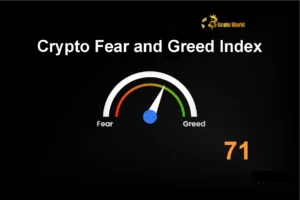Altcoin Season Index Plummets: Is Bitcoin Season Here?

BitcoinWorld
Altcoin Season Index Plummets: Is Bitcoin Season Here?
Hey there, fellow crypto enthusiasts! Ever wonder if it’s the season for altcoins to shine or if Bitcoin is still calling the shots? There’s a cool tool that helps us get a sense of this – the Altcoin Season Index. And right now, this index is flashing a clear signal: we’re deep into Bitcoin Season.
Understanding the Altcoin Season Index
So, what exactly is this index? The Altcoin Season Index is a metric provided by platforms like CoinMarketCap (CMC) that gives us a snapshot of the current state of the cryptocurrency market. It helps determine whether altcoins, as a group, are outperforming Bitcoin over a specific period, or if Bitcoin is leading the pack.
Here’s the breakdown:
It tracks the performance of the top 100 cryptocurrencies by market capitalization listed on CMC.
Crucially, it excludes stablecoins (like USDT, USDC) and wrapped tokens (like wBTC) because their price movements aren’t driven by speculative trading in the same way as other cryptocurrencies.
The index looks at the performance of these top 100 coins compared to Bitcoin over the past 90 days.
The score ranges from 1 to 100. A high score suggests altcoins are performing strongly relative to Bitcoin, while a low score indicates the opposite.
Think of it like a market barometer, helping us see whether the general trend favors diversified altcoin portfolios or a focus on the market leader, Bitcoin.
Decoding Bitcoin Season vs. Altcoin Season
The Altcoin Season Index isn’t just a number; it tells a story about market dynamics. The index uses specific thresholds to define different market phases:
Altcoin Season: This is declared when at least 75% of the top 100 altcoins (excluding stablecoins and wrapped tokens) have outperformed Bitcoin over the past 90 days. The index score would typically be high, often above 75. During Altcoin Season, you’d generally see many altcoins experiencing significant price pumps, sometimes far exceeding Bitcoin’s gains.
Bitcoin Season: This occurs when 25% or fewer of the top 100 altcoins have outperformed Bitcoin over the past 90 days. The index score is low, typically 25 or below. In Bitcoin Season, Bitcoin tends to be the dominant performer, either holding its value better during downturns or leading the charge during uptrends, while many altcoins might lag behind or even decrease in value relative to BTC.
Neither: If the market doesn’t meet the criteria for either Altcoin Season or Bitcoin Season (i.e., between 25% and 75% of altcoins outperformed Bitcoin), the market is considered to be in a neutral phase.
As of May 20th, the index registered a low 21. This figure is down from recent days, solidifying the market’s position in Bitcoin Season according to this metric.
What the Current Crypto Market Shift Means
An index reading of 21 is a strong signal that the broader crypto market is currently being led by Bitcoin. This isn’t just a theoretical concept; it has practical implications for investors and traders.
Here’s what being in Bitcoin Season typically implies for the crypto market:
Bitcoin Dominance: Bitcoin’s market capitalization relative to the total crypto market cap tends to increase or remain high. This means a larger portion of the money flowing into crypto is going into Bitcoin.
Altcoin Underperformance: While some individual altcoins might still perform well due to specific news or developments, the majority are likely to underperform Bitcoin on average. This can be frustrating for altcoin holders.
Risk Perception: In times of uncertainty or during the initial stages of a market recovery, investors often flock to Bitcoin as the most established and liquid asset in the crypto space, viewing it as a safer bet compared to smaller, more volatile altcoins.
Capital Rotation: Sometimes, Bitcoin’s strong performance is the first phase of a bull run. Capital flows into Bitcoin first, and only later, if the rally sustains, does it rotate into larger-cap altcoins, and then eventually into smaller-cap altcoins. Bitcoin Season can sometimes precede a potential Altcoin Season, but it’s not guaranteed.
The current index reading confirms that, over the last three months, Bitcoin has been the dominant performer against the vast majority of the top 100 altcoins.
Navigating Altcoins in a Bitcoin-Dominated Market
Does being in Bitcoin Season mean you should ignore altcoins entirely? Not necessarily, but it does mean adjusting your strategy and expectations. Here are some considerations for dealing with altcoins when the index is low:
Focus on Quality: Instead of spreading investments thinly across many altcoins, concentrate on projects with strong fundamentals, clear use cases, active development teams, and engaged communities. These are more likely to weather periods of underperformance relative to Bitcoin and potentially bounce back stronger.
Manage Risk: Volatility can be high. Consider reducing position sizes in riskier altcoins or setting stop-loss orders to protect capital.
Watch Bitcoin: Bitcoin’s price action is crucial. Often, when Bitcoin makes a significant move (up or down), altcoins follow, but with amplified volatility. Understanding Bitcoin’s trend can inform decisions about altcoin positions.
Look for Specific Catalysts: Some altcoins may pump independently due to specific news, mainnet launches, partnerships, or upgrades. Research individual projects rather than relying solely on the overall altcoin market trend.
Accumulation Opportunities: For long-term investors, periods when altcoins are underperforming Bitcoin can sometimes present opportunities to accumulate positions in favored projects at lower relative prices.
Remember, the index is a backward-looking metric (based on the last 90 days). While it indicates the recent trend, it doesn’t predict the future. However, it’s a valuable tool for understanding the prevailing market sentiment and performance dynamics.
The Role of Bitcoin in the Current Environment
In a market flagged as Bitcoin Season, the focus naturally shifts to Bitcoin itself. Bitcoin’s performance often dictates the overall mood and direction of the crypto market. Its stability (relative to altcoins) and increasing institutional interest, particularly with the advent of spot Bitcoin ETFs in various regions, solidify its position as the anchor of the digital asset space.
During this phase, observing Bitcoin’s price movements, trading volume, and market sentiment becomes even more critical. A strong, steady Bitcoin can provide a foundation, while volatility in Bitcoin can send ripples throughout the entire ecosystem, disproportionately affecting altcoins.
For investors, this might mean a higher allocation to Bitcoin or using its movements as a primary indicator for timing trades in other assets.
Summary: Navigating the Seasons
The Altcoin Season Index currently sits at a low 21, clearly indicating that the market is in Bitcoin Season. This means that over the past 90 days, Bitcoin has largely outperformed the vast majority of the top 100 altcoins. Understanding this dynamic is key to navigating the current crypto market. While Bitcoin leads, investors in altcoins should exercise caution, focus on quality projects, manage risk diligently, and keep a close eye on Bitcoin’s performance. The crypto market is cyclical, and while we are currently in Bitcoin Season, the tides can always turn. Staying informed and adapting your strategy is crucial for success in this ever-evolving landscape.
To learn more about the latest crypto market trends, explore our articles on key developments shaping Bitcoin and altcoins price action.
This post Altcoin Season Index Plummets: Is Bitcoin Season Here? first appeared on BitcoinWorld and is written by Editorial Team








